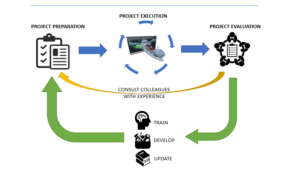Quality Management at C-Job
As you would expect from C-Job, many of the subjects covered here in the Newsflash are about measurable, data-based topics. Articles about computational fluid dynamics and vibration assessments spring to mind. This is because the field of naval architecture and maritime engineering is inherently objective. That is why, with this article, we have decided to put a more subjective subject in the spotlight: quality management.

C-Job views quality management with high regard, taking active steps to continuously improve its internal processes, and therefore its services to clients. The most noticeable characteristic of quality management is that, compared to other activities within the company, it is a more conceptual subject. “That’s because quality is subjective – it is more of a feeling of the overall experience of C-Job,” says Danielle Terpstra, Quality Manager at C-Job.
The impression gained by the client at C-Job shows the level of quality management. “Maybe we have generated a fantastic design, but if it’s not what the client had asked for, then we are not delivering on quality. Therefore it’s very important to know what the client wants. It’s about managing mutual expectations.”
People, resources & processes
Danielle defines quality management as “the principle of meeting the needs and expectations of the customer – or perhaps exceeding them a little.” This means that quality management is not a subject that can be departmentalized. On the contrary, it is a way of thinking and working that has to be upheld by everyone in the company.
In her role of Quality Manager, Danielle says that there are three key aspects to attaining consistent levels of quality. “You need to have the right people, the right resources, and the right processes.”
- The right people
This is the team of more than 180 people working at C-Job’s seven different offices. These are the ‘C-Jobbers’: skilled experts, with a passion for their work. Training and skills development is an integral part of keeping levels of quality high.
- The right resources
These are the tools with which the teams use to do their work. Computers and software, for instance, all have to be of the highest quality.
- The right processes
The primary processes are the most important, involving the ‘customer-to-customer’ concept. This starts with the sales team’s contact with the client. And ends with the delivery of the finished product. This image below illustrates this flow of processes.

Danielle points out the importance of communication in maintaining (or better still, improving) quality. “Communication is crucial for integrated quality management,” she explains. “Each step is extremely important as the project is handed over to the next phases. And don’t forget, that the lines of communication must go both ways. It is also important to evaluate the things that can be improved or kept as they are. If all these processes are in place and under control, then you have much less chance of making mistakes.”
Zero mistakes
Reducing the chance of errors brings us to another concept with the field of quality management: that of ‘zero mistakes’. There are numerous benefits of zero mistakes. As well as the obvious ones like higher customer satisfaction and a higher rate of returning customers, it also decreases overheads and automatically increases the speed of a project. “In general, there are less unknowns and uncertainties and there is more room for the creation of great results.”
While the idea of zero mistakes may sound like paradise for any company, Danielle is quick to emphasize that this is not actually a realistic goal. “It is a utopia,” she notes. “Quality management is an investment in terms of time and money. Therefore, what it can deliver in terms of zero mistakes only goes to a certain point, after which things take too long and cost too much. The main point is that we need to be continuously improving – in a proactive way, rather than a reactive way.”
Continuous improvement
Striving towards continual improvement is a lot easier when a company knows what it is doing well and what it needs to improve. This includes identifying and managing internal and external risks for the organization as well as on a per-project basis. “We need to know what could go wrong and how do we mitigate this. Also which issues need to be improved and in are which running optimally.”
This requires a surefire way to analyze the performance of past projects – something that C-Job accomplishes by undertaking internal audits, monitoring and project evaluations. “These measure quantifiable goals and KPIs. In the sales process, for example, how successful is the quotation processes? Or how satisfied are our customers?”

“At C-Job we call this the process of the ‘return of experience’. All information is brought back into the company by means of training, development of tools and updates of procedures, instructions, and information.”
With this knowledge at its disposal, C-Job can then implement improvements to ongoing or future projects. These represent the company’s goals for the future, to be achieved with the philosophy of constant improvement always at the front of mind.